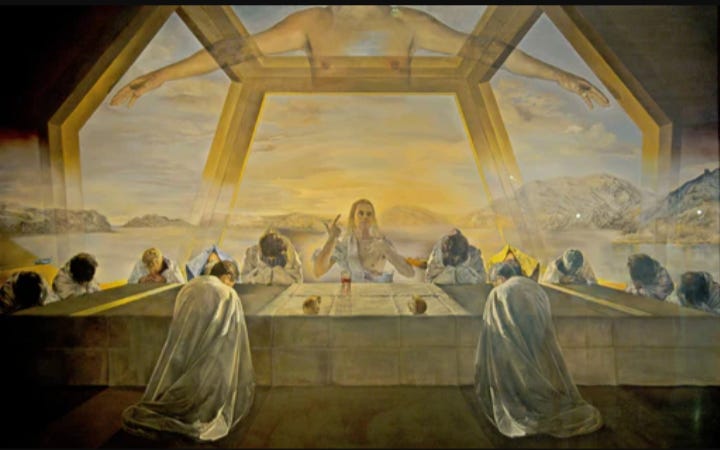Christ, Dalí, 'The Crucifixion of the Christ’
Yukio Mishima
I like Dalí's recent sacred paintings, 'The Last Supper' at the National Gallery in Washington and 'The Crucifixion of the Christ' at the Metropolitan Museum in New York, both in equal measure, but I chose the simpler composition and clearer colours of 'The Crucifixion' for its effectiveness as a reproduction. The details of 'The Last Supper,' such as the wine in the cups, are so clear and holy that they are almost dazzling to the eye, but unfortunately, a facsimile would not have even a tenth of the effect. 'The Crucifixion of the Christ' was painted in 1954, but it receives unparalleled treatment at the Metropolitan Museum, where it always attracts a throng of visitors. It was unimaginable that Dalí would become a Catholic and paint a picture that smelled of incense, considering the Dalí of old, but when I think about it, the infinite expanse of the clear sky and the vast perspective of the background that appear persistently in the early Dalí, I feel a sense of anticipation that one day, from the end of that horizon, a holiness will not fail to emerge. There was a sense of foreboding that holiness would not fail to emerge from the edges of the horizon. Dalí's study of detailed realism in Renaissance and Dutch still-life paintings also gave him the feeling that he would one day come across material that would demand the full use of such techniques. From this point of view, Dalí's sacred paintings are not a bit of a mystery.
In this 'Crucifixion of the Christ,' the crucifix is painted in the Cubist style, and both Christ and the crucifix are completely suspended in the air, creating what might be described as a sacred metaphysical space. The Mary in the lower left is painted in a completely Renaissance style, and the contrast and tension in the composition are unparalleled. Below, the familiar distant horizon is depicted with a hint of the dawn's blue light, shining faintly. The depiction of Christ, a beardless, young Christ, is not filled with middle-century theism, but rather with a youthful freshness reminiscent of American physicalism. It is almost as if Christ had just a few moments earlier been wearing the jumper of a modern carpenter. This may be one of the factors that moved many Americans, and the psychoanalytically informed artist may have been aiming for a messianic complex that is still alive in the modern age.
Dalí, "The Crucifixion of the Christ", My Favourite Modern Paintings, first published in Mademoiselle, August 1958 Dalí, "The Crucifixion of the Christ", first published in My Itinerant Age, Kodansha, April 1963.




